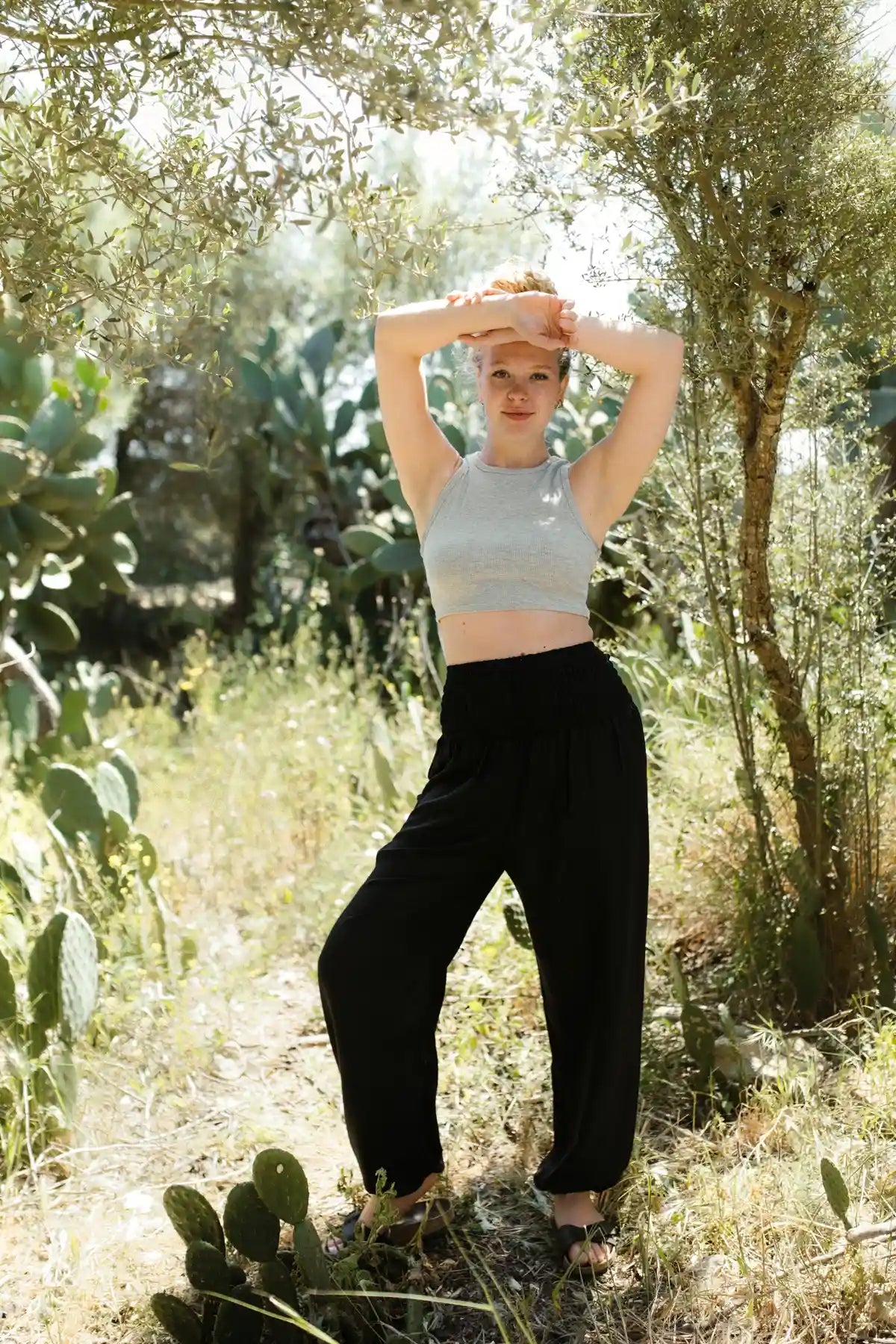
Inhaltsverzeichnis
Die besten pflanzlichen Eisenquellen
Eisen ist ein essentieller Nährstoff und wichtig für unseren Körper. Aber wieso eigentlich? Wie viel Eisen benötigt unser Körper? Und welche pflanzlichen Lebensmittel haben einen hohen Eisengehalt? Wir stellen dir sieben vegane Eisenquellen vor, die du in deine Ernährung mit einbeziehen kannst.
Wofür benötigt unser Körper Eisen?
Eisen findet sich in jeder unserer Körperzellen und gehört zu den wichtigsten Spurenelementen überhaupt. Es bindet Sauerstoff in den roten Blutkörperchen und ist damit für den Transport von Sauerstoff durch den gesamten Körper zuständig. In Leber, Milz und Knochenmark befinden sich außerdem Eisenspeicher, an denen der Körper sich bei Eisenknappheit bedienen kann.
Es wird zwischen Hämeisen und Nicht-Hämeisen unterschieden. Hämeisen liegt besonders in tierischen Lebensmitteln (vor allem in Fleisch) vor. Es kann von unserem Körper (bis zu dreimal) besser absorbiert werden als Nicht-Hämeisen. Weil Nicht-Hämeisen insbesondere in Pflanzen vorkommt, ist es für Nicht-Fleischesser wichtig zu wissen, was die besten pflanzlichen Quellen von Eisen sind.
Aufgrund der unterschiedlich hohen Resorbtionsraten ist Eisenmangel besonders bei Vegetarier*innen und Veganer*innen keine Seltenheit. Symptome von Eisenmangel sind Ermüdung, Schwindel, Benommenheit und eine blasse Haut. Ob du von Eisenmangel betroffen bist, lässt sich am besten anhand eines Bluttests feststellen.
Wie viel Eisen sollte ich zu mir nehmen?
Der Eisenbedarf eines Menschen ist nicht immer gleich. Faktoren wie das Alter, das Geschlecht oder die derzeitige Lebensphase beeinflussen die Menge, die unser Körper an Eisen benötigt. Im Wachstum sowie während der Schwangerschaft und Stillzeit ist der Eisenbedarf beispielsweise besonders hoch.
Grundsätzlich wird gesunden weiblichen Erwachsenen empfohlen, täglich 15 mg Eisen zuzuführen. Männer benötigen etwas weniger Eisen, bei ihnen werden 10 mg täglich empfohlen.
Ich habe unten bei der Auflistung der eisenhaltigen Lebensmittel als Richtwerte sowohl die Eisenmenge pro 100 g aufgeführt, als auch die Verzehrmenge, die benötigt wird, um 15 mg Eisen zuzuführen. Die Werte dazu stammen von eisencheck.at.
Übrigens gibt es einige Lebensmittel, die die Eisenaufnahme im Körper hemmen können. Dazu gehören schwarzer Tee, Kaffee, Weißmehlprodukte sowie Milch- und Milchprodukte. Lebensmittel, die die Eisenaufnahme unterstützen sind Vitamin C-haltige Lebensmittel (v.a. Gemüse, Obst und Fruchtsäfte).
Wenn du mehr eisenhaltige Nahrungsmittel in deine Ernährung implementieren möchtest, oder vielleicht aufhören möchtest, Nahrungsergänzungsmittel zu dir zu nehmen, dann kann dir diese Liste dabei helfen. Du siehst, woher du Eisen bereits bekommst und an welchen Stellen du mehr eisenhaltige Lebensmittel zu deiner Ernährung hinzufügen kannst.
Vegane Eisenquellen
1. Sojabohnen
Auch wenn Sojabohnen nicht nur auf Beliebtheit stoßen, sind sie dennoch ein sehr gesundes Lebensmittel. Die Hülsenfrucht stellt bekanntermaßen eine wertvolle pflanzliche Eiweißquelle dar. Darüber hinaus enthalten Sojabohnen neben Vitaminen auch viel Kalzium und Eisen. Sojabohnen kommen zwar ursprünglich aus Asien, seit einigen Jahren werden Sojapflanzen aber auch in Deutschland und Umgebung angebaut. Besonders Populär sind Sojabohnen in Form von Tofu, Tempeh oder auch in Form von Pflanzendrinks und -joghurts. Beim Kauf sollte auf Bioqualität und Regionalität geachtet werden.
100 g Sojabohnen enthalten ca. 9 mg Eisen (Verzehrmenge für 15 mg Eisen: 154 g Sojabohnen).
2. Linsen
Jedes Mal, wenn ich Linsen esse, denke ich, dass ich öfter Linsen essen sollte. Wie Sojabohnen sind Linsen reich an Protein und Nährstoffen wie Eisen und Vitamin K. Sie schmecken nicht nur lecker sondern sind auch schön vielseitig einsetzbar! Als Suppe, als Beilage, in Salaten… Auch Pasta auf Linsenbasis ist mittlerweile in den meisten Supermärkten erhältlich!
100 g Linsen enthalten ca. 8 mg Eisen (Verzehrmenge für 15 mg Eisen: 187 g Linsen).

Photo by James Sutton on Unsplash
3. Quinoa
Ebenso vielfältig einsetzbar ist Quinoa. Anders als herkömmliches Getreide enthält Quinoa kein Gluten und ist daher besonders für Allergiker geeignet. Quinoa enthält - neben Eisen - auch Protein und gesunde Ballaststoffe und ist reich an essentiellen Aminosäuren. Das Pseudogetreide kann gut als Alternative für Reis verwendet werden und enthält 8 mg Eisen pro 100 g. Die Quinoa-Verzehrmenge für 15 mg Eisen beträgt ebenfalls 187 g.
4. Kürbiskerne
Auch so ein Nahrungsmittel, das die meisten von uns wohl nicht so “auf dem Schirm haben”. Dabei kann man Kürbiskerne so gut in verschiedene Gerichte untermischen! Besonders geeignet sind die Kerne in Salaten, im Smoothie und im Müsli. Aber auch als Topping auf warmen Speisen machen sich Kürbiskerne gut, weil sie dem Ganzen einen schönen Crunch verleihen. Kürbiskerne sind reich an Vitaminen und liefern Magnesium, Eisen, Zink und Selen. Mit 11,2 mg Eisen pro 100 g gehören Kürbiskerne zu den Nüssen/Samen mit dem höchsten Eisengehalt (Verzehrmenge für 15 mg Eisen: 170 g Kürbiskerne).
5. Kichererbsen
Kichererbsen gehören für mich mittlerweile schon fast zu den Grundnahrungsmitteln! Denn Kichererbsen sind nicht nur günstig und lange haltbar, sondern auch reich an Nährstoffen. So enthalten sie neben Eisen viele Ballaststoffe, Proteine, Calcium und Vitamin E. Damit sättigen sie nachhaltig, festigen Knochen und beugen Alterungsprozesse der Haut vor. Ein anderer Grund, wieso Kichererbsen immer in meinen Vorratsschrank gehören ist, dass sie super vielseitig sind. Am liebsten mache ich aus ihnen Hummus! Sie eignen sich aber auch perfekt für Eintöpfe, Currys oder ganz schlicht als Beilage.
100 g getrocknete Kichererbsen enthalten ca. 6,1 mg Eisen (Verzehrmenge für 15 mg Eisen: 245 g Linsen).

Photo by Hermes Rivera on Unsplash
6. Hirseflocken
Hirseflocken gehören nicht unbedingt zu den Lebensmitteln, die man immer zuhause hat. Aber auch hier lohnt sich die Anschaffung. Die Flocken sind recht preiswert in Bioläden und Reformhäusern zu finden und machen sich super in selbstgemachtem Müsli oder einem schnellen Hirsebrei. Die Flocken beugen einer Übersäuerung vor und unterstützen einen gesunden Cholesterinspiegel. Darüber hinaus sind sie natürlich reich an Eisen (wer hätte das gedacht? ;) ) und glutenfrei!
In 100 g Hirseflocken sind ganze 9 mg Eisen enthalten. Die Verzehrmenge für 15 mg Eisen liegt dementsprechend bei 160 g Hirseflocken.
7. Weiße Bohnen
Weiße Bohnen sind ganz gewiss vielseitiger, als sie nur für den Eintopf zu gebrauchen. Wie andere Bohnen haben auch weiße Bohnen einen hohen Proteingehalt. Außerdem sind sie - neben Eisen - reich an Magnesium (und damit gut für die Muskeln) und enthalten viele Ballaststoffe, die die Verdauung unterstützen. Weiße Bohnen lassen sich in Eintöpfen, Suppen und Salaten verarbeiten oder als Beilage verwenden. Man kann aus den Bohnen aber auch leckere Dips und Brotaufstriche herstellen!
Übrigens ist nicht nur diese Bohnenart eisenhaltig. Sie ist hier spezifisch aufgeführt, weil sie besonders viel Eisen enthält – an sich sind Bohnen aber generell ein guter Eisenlieferant!
100 g getrocknete weiße Bohnen enthalten ca. 7 mg Eisen (Verzehrmenge für 15 mg Eisen: 215 g).
Noch ein Wörtchen zu Spinat: Der gilt oftmals als DIE Eisenquelle schlechthin. Das ist im Grunde aber nur ein Mythos. Spinat enthält zwar nicht wenig Eisen, aber dafür auch andere Stoffe, die die Eisenaufnahme im Körper hemmen. Andere pflanzliche Lebensmittel wie Linsen oder Bohnen bilden daher bessere Eisenquellen.
Hat dir dieser Beitrag gefallen? Du hast Ergänzungen, Fragen oder Kritik? Dann hinterlasse uns gerne einen Kommentar direkt unter diesem Beitrag! :)
Wenn du noch mehr über die Themen gesunde Ernährung, Achtsamkeit oder Nachhaltigkeit erfahren möchtest, schaue doch mal hier vorbei.

Photo by Tijana Drndarski on Unsplash


























Leave a comment
This site is protected by hCaptcha and the hCaptcha Privacy Policy and Terms of Service apply.